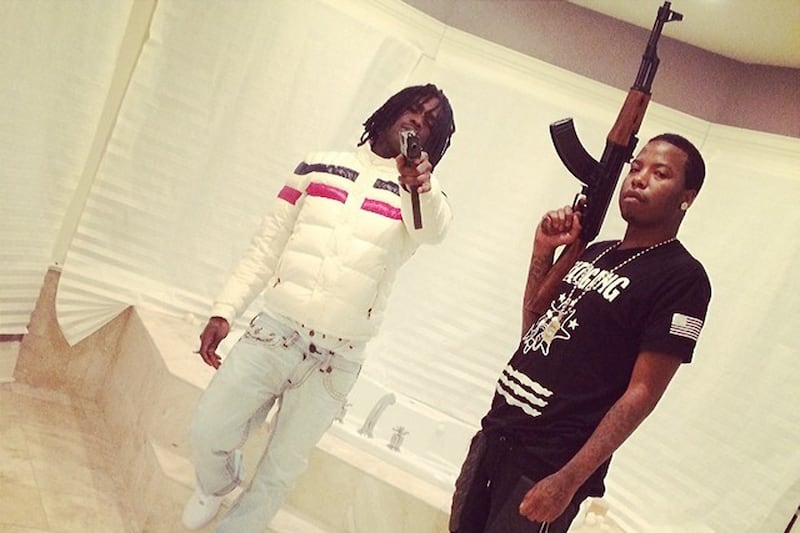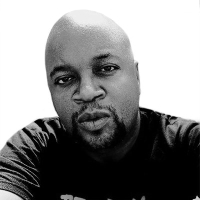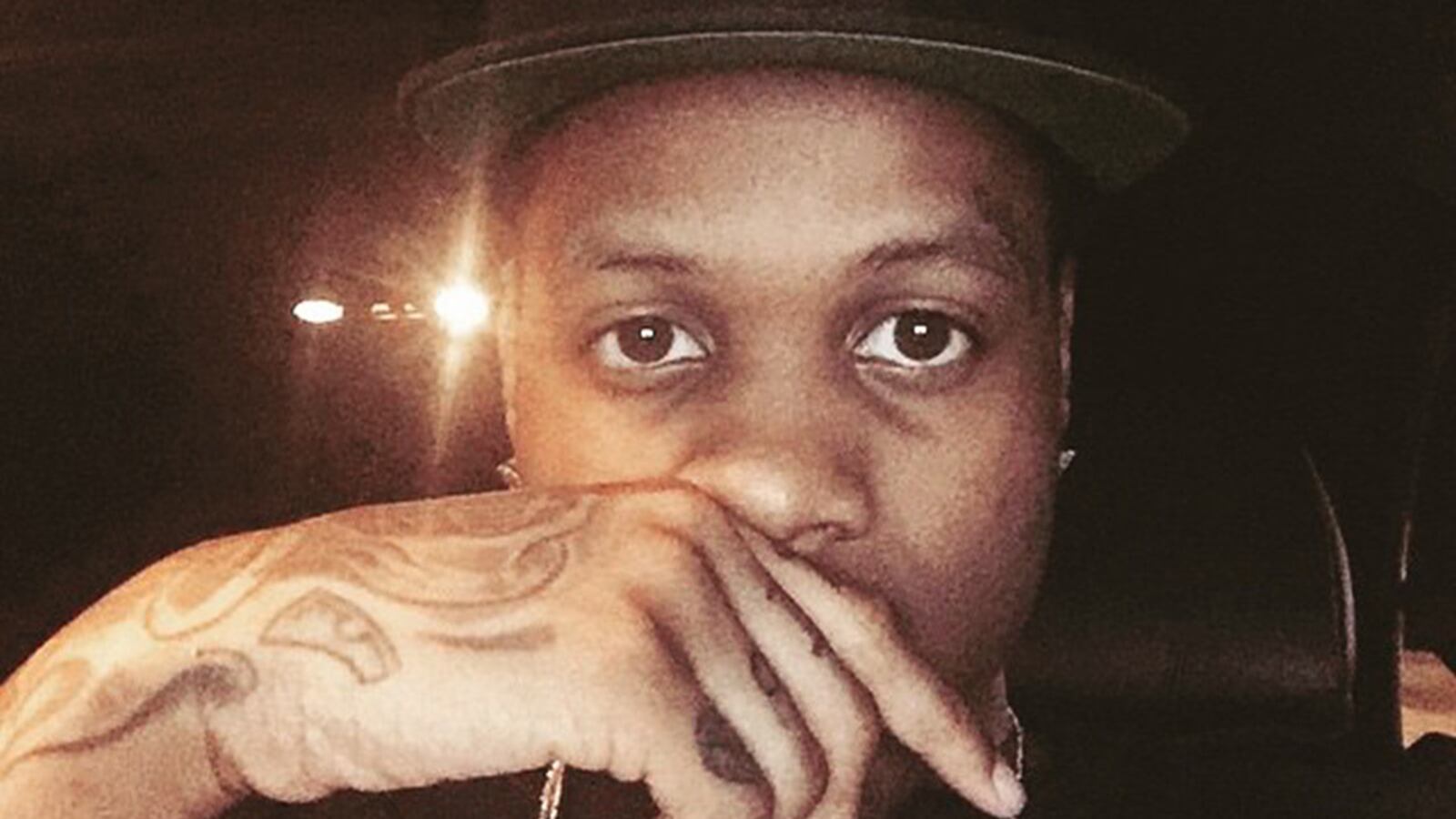Lil Durk isn’t looking back. Two years ago, the Chicago native Durk Banks became affiliated with French Montana’s Coke Boys imprint, and now, his Def Jam debut is set for release on June 2. The 22-year-old that used to bang with the Black Disciples was realizing his hip-hop dreams. But hip-hop dreams weren’t something kids in Englewood held on to for very long, and Durk wasn’t exactly walking around with a rhyme book.
“I wasn’t really into music. I was into the streets,” he admits. “I was too worried about the streets and how I was going to eat and how I was going to make the streets happen. I was 17 when I first started rapping and 18 before I started taking it seriously—when I really knew I could rap and have fans and be a trendsetter.”
Recognizing his potential as a hip-hop artist was obviously an important milestone for the then-teenager. Durk makes it clear that, in his hometown, just allowing yourself to believe that you have a talent that could take you away from a lifestyle of bangin’ is a feat unto itself. For decades, America has loved sad hip-hop stories, but the violence in Chicago has cast an ominous cloud over the reputation of one of America’s greatest cities. In July 2014, 82 people were shot, 16 of them killed, during Independence Day weekend. A generation has grown numb to the death, and Durk says that in Englewood, hope is in decidedly short supply.
“In Chicago, a lot of people don’t really got nothing to live for,” he shares. “Everybody can’t ball. Everybody can’t rap. Nobody is really doing those activities. There’s nothing to do but the streets. The streets or school. A lot of people don’t like going to school, so a lot of people are stuck to the streets.”
“Growing up there is kind of hard,” he continues. “It’s not like Los Angeles or New York, where you can finesse. Growing up in Chicago is hard. I’d say 80 percent of the people ain’t really got no daddies. Their household wasn’t right. All they know is the streets and getting some money to support each other and support their family.”
A generation ago, it was a notorious South Central Los Angeles neighborhood that was beginning to draw attention and court controversy, churning out artists specializing in harrowing street tales. In the late 1980s and early 1990s, Compton, California-based artists like DJ Quik, Compton’s Most Wanted, and most famously, N.W.A., brought gangsta rap to the forefront of hip-hop. And very vocal critics with names like C. Delores Tucker and Calvin Butts took aim at those artists for what they viewed as glorification of criminality. Similarly, today’s South Side rappers are giving voice to the rage and pain of the streets; but there is the constant fear that the music is breeding more animosity and championing a lifestyle that lands too many young black people in the city’s morgues.
A young Ice Cube wrote songs like “Gangsta, Gangsta” and “Boyz N the Hood.” He grew up in a two-parent household and was studying architectural drafting at the Phoenix Institute of Technology when he connected with his soon-to-be N.W.A. bandmates, Eazy E and Dr. Dre. Chief Keef, on the other hand, was a Black Disciple-affiliated convicted felon under house arrest when his web presence began to grow. There is a sense that there is zero difference between these artists’ musical personas and the lifestyles they come from—and that immediacy is worrying.
For Durk, his banging days were all that mattered until he began having children and married Nicole Covone. The young rapper had a reason to refocus: Fatherhood saved him from banging on the streets of Englewood.
“I had buckled down when I had my son,” he recalls. “I really stopped doing everything I did and got my head right, because every night I had to wonder where his next meal was going to come from. When I [thought] about rapping, I saw that it could be different. A lot of people started paying attention to it—and people wanted to interview me, so I started taking it seriously.”
“That was really a key to getting me focused and seeing if I could do this: my kids,” he says, before adding, “And going to jail.”
Durk was arrested on a weapons charge in October 2011 after he was pulled over for drinking in his vehicle and police discovered he was in possession of a gun. He served three months in Vandalia State Prison before he was released on bond—only to return to prison for 87 more days. In June 2013, Durk was arrested after police said he’d attempted to toss a .40 caliber handgun in his car when officers approached him.
In 2013, Durk’s associate Chief Keef inked a deal with Interscope Records worth a reported $6 million. The Chief Keef deal received a significant amount of attention and scrutiny because of the hefty number, the rapper’s youth and history, and the very real violence rampant on the streets of Chicago. Durk is honest about the fact that the elevation of hardcore rappers doesn’t just make hardcore visible—it makes it fashionable.
“The people who came out of Chicago first are the trendsetters, so now everybody who comes out of Chicago wants to do the same thing and follow in the same footsteps,” he feels. “Everybody want to be hardcore, they hear about Chicago being hardcore, so they want to come out hardcore. But they can’t even find their own self.”
“[Artists] raps make these people believe that they really doing what they say in their raps and they’re really not,” Durk adds. “It’s 50/50. Even people outside of Chicago who say our words and things that we say—they’re not really about it. They’re just going along with what’s hot. “

That trendiness hasn’t bred a sense of camaraderie—at least, not in Durk’s eyes. The bad blood that breeds conflict on Chicago’s streets is reflected in the music and the way artists interact with each other.
“Everybody’s not together in Chicago right now,” Durk believes. But he’s decided to keep his distance because of his commitment to telling his own story. That attitude has led to friction. “Don’t nobody really want to see nobody win. ‘If I don’t do no song with you, I ain’t cool with you.’ But it ain’t like that. I’m more focused on myself right now and people don’t really get it. They turn it into hatred or competition. I bang with you for four, five years, but I don’t want to do no song with you and you turn it into competition? So being in Chicago right now is all competition. It’s all hate. Nothing positive and everything negative.”
“To me, personally, in your own city there’s always going to be some kind of hatred,” he says. “Outside of Chicago, it’s love. Other artists do some with you, politic, go chill. Hate is everywhere, but you ain’t really got to worry about it like that. It’s Chicago specifically. It’s something about Chicago—that hatred.”
In September 2013, Durk’s friend, rapper L’A Capone, was shot and killed leaving a South Shore recording studio. Just this March, his manager and longtime friend, Uchenna “Chino Dolla” Agina, was killed in Avalon Park.
“Chino was my brother,” Durk somberly says. “I grew up with him and he taught me a lot of stuff. His presence was, like, energy in the studio. He wanted me to keep going and work on what we established and focus on music. He’d always tell me, ‘You can’t be in the streets and do music.’ So with him passing, if I stopped, I’d let him down. He’d want me to keep going. It’s sad and I’m angry, but I sit in my room and talk to him.”
Remember My Name is the culmination of a long and dark road for Durk. His album’s release is also validation for the rhymer—he’s reaping the rewards of hard work and walking away from a life that could’ve killed him. But even with his success, that connection to those South Side streets remains an indelible part of who he is. Rising above that hate and showing others from Chicago how to as well have become top priorities for Lil Durk.
“I want them to know the real,” he says. “I just want to paint the picture of Chicago that no one has really painted. Of what’s going on today. Not 1990—none of that. 2015. I want to make a statement that this is what’s going on. This is real. Don’t blame us for nothing that’s going on. I want to stamp my name to it. Positive. Nothing negative. And let them know that Chicago artists can do it, too. Like Durk, too. And just imagine if he’d had a full support system behind him. Even after this album, if it do good or bad, I’m going to be happy with the project. A lot of people in Chicago who rap never really came out with no album. Unless you’re like a Kanye or Common. So I want to be among the first with the trend in my city, showing them something different other than shoot ’em up, bang-bang, rap beefing. I want to bring everybody together.”
Durk’s family and his neighborhood are what push him to aim higher, but they motivate him in polar opposite ways. The warmth of family keeps him hopeful and inspired; the coldness of the streets makes him hungry and sharp. And both sides of that coin have gotten him where he is.
“It’s family first. My kids are what motivate me. Knowing that they’re on this earth and look at me, family looks at me,” shares Durk. “And the violence that goes on in Chicago, and the hate or the rumors I hear, it really motivates me to go in the studio and do better. Sounds crazy, but it motivates me. None of it ever gets to me. I just stay in the studio and I focus and that’s my motivation. Hatred and family.”






